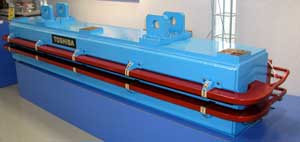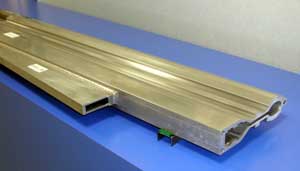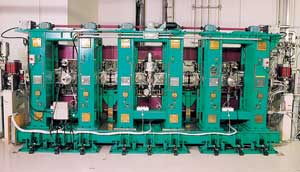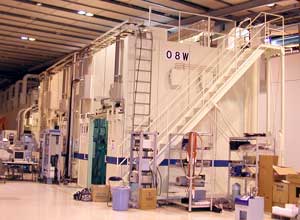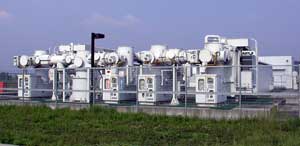FAQ
 General questions about SPring-8
General questions about SPring-8
(1-1) What type of facility is SPring-8? What types of experiment are carried out using synchrotron light at SPring-8?
SPring-8 is a third-generation large-scale synchrotron radiation facility for research and experiments using synchrotron radiation (synchrotron light) emitted from a high-energy electron beam.
The research fields utilizing synchrotron radiation and some research examples are as follows:
Materials Science: Atomic and electronic structures of advanced materials. Material properties under extreme conditions. Development of new materials. Material reforming.
Life Science/Medical Applications: Structural analysis of proteins, leading to research of life mechanisms and drug design/development etc. High-resolution imaging of biological samples using the phase-contrast method.
Environmental Science: Analysis of environmental catalysts. Analysis of environmental pollution trace elements contained in biological samples.
Earth and Planetary Science: Analysis of the structures and properties of Earth's deep crust materials. Structural analysis of meteorites and cosmic dust.
Industrial applications: Material evaluation. Structural analysis of proteins.
(1-2) Who does SPring-8 belong to?
SPring-8 is shared facility for synchrotron radiation under the jurisdiction of Japan's MEXT (Ministry of Education, Culture, Sports, Science and Technology). RIKEN (The Institute of Physical and Chemical Research) is the owner of SPring-8, and the Japan Synchrotron Radiation Research Institute (JASRI) has been managing and operating it.
(1-3) Which facility is called SPring-8?
SPring-8 is the general name for the entire facility, including the Linac (Linear Accelerator), Synchrotron, Storage Ring, Beamlines and attached facilities. However, SPring-8 sometimes refers narrowly to just the Storage Ring and the Beamlines.
(1-4) How many people work for SPring-8 and SACLA?
As of October 2017, approximately 441 staff members work for SPring-8 and SACLA. Furthermore, members of other organizations also work in this site, such as NewSUBARU Synchrotron Radiation Facility belonging to University of Hyogo, Hyogo-prefectural Synchrotron Radiation Nanotechnology Laboratory and Japan Atomic Energy Agency. In addition to the staff, while SPring-8 and SACLA are in operation, about 250 users daily perform experiments in the facilities.
(1-5) Who are the users of the SPring-8 facility? Are there any foreign users?
The users of the facility are researchers from domestic national/private universities, research organizations, and private enterprises. Researchers from overseas institutes and universities are also users of SPring-8.
(1-6) How do we apply to use SPring-8?
Research proposals are invited twice every year and are submitted to JASRI.
Please visit the website for more information.
(1-7) How much does it cost to use SPring-8?
If you publish your research results after the experiment, there is no charge for use of the SPring-8 facility. If you do not disclose your results, there is a fee of 60,000 yen per hour (480,000 yen / 8 hours) for beam use.
(1-8) Does the name "SPring-8" mean anything?
SPring-8 is a nickname of the facility which comes from "Super Photon ring (= ring accelerator or storage ring) 8 GeV (8 giga electron-volts)."
The formal name is the Large-scale Synchrotron Radiation Facility.
(1-9) How much did it cost to construct SPring-8?
The initial construction cost was approximately 110 billion yen. In addition, Hyogo Prefecture donated the site.
(1-10)What is the annual operating budget for SPring-8 and SACLA?
The budget of SPring-8 for operating and maintenance is approximately 8.5 billion yen and that of SACLA is approximately 5.6 billion yen in FY 2018. The budget for promotion of utilization, applied to both SPring-8 and SACLA, is approximately 1.4 billion yen in FY 2018.
(1-11) What is the operation schedule of SPring-8?
The operation of SPring-8 is scheduled in runs of two or three weeks. SPring-8 operates 24 hours a day during a run.
(1-12) What is produced at SPring-8?
Since SPring-8 is an experimental facility for analysis and not a manufacturer, no production takes place at the facility.
For example, although the structural analysis of proteins for drug design/development is performed at the Pharmaceutical Industry Beamline (BL32B2), the drugs are not developed at SPring-8.
(1-13) Does the Hyogo Ion Beam Medical Center use the synchrotron radiation from SPring-8?
Since the Hyogo Ion Beam Medical Center is an independent organization, they do not use the synchrotron radiation from SPring-8.
The Hyogo Ion Beam Medical Center uses not light but an ion beam to treat tumors.
(1-14) Is it possible to identify a meteorite-like stone that I have?
The way SPring-8 is currently utilized, it is almost impossible to identify objects from individual collections. It may become possible if a consignment analysis service system is available in the future.
(1-15) What is the difference between Large Hadron Collider (LHC), which claimed the discovery of the “Higgs particle,” and SPring-8? Is SPring-8 capable of performing experiments similar to those carried out in LHC?
Both LHC and SPring-8 are accelerator-based*1 facilities, but the types of particles they accelerate and their intended purposes are distinctly different.
SPring-8 is a synchrotron radiation facility in which an accelerated beam of electrons is bent under the effect of magnets to generate synchrotron radiation (hereafter referred to as “SR”). The SR is widely used in a variety of scientific disciplines and industrial sectors as it provides a probe into the “Nano-world,” i.e. it is a means for atomic-level observation, measurement and analysis of the structure and dynamic behavior of materials, and material compositions.
On the other hand, LHC accelerates protons, a type of hadron, for head-on collision, allowing examinations of the reactions, or phenomena, triggered by the collision. Research into the elementary particles—fundamental particles, such as quarks, electrons, neutrinos, and photons, that are believed to be non-dividable into smaller entities—are being carried out in this facility.
SPring-8 also provides beam-lines for elementary particle studies. The laser electron photon beam-line prepared by Osaka University is mainly used for quark research,*2 where an ultraviolet laser is directed head-on against the stream of electrons generated by SPring-8, producing recoiled photons with extremely high energy and short wavelengths (gamma ray).
*1 Accelerator
An apparatus for generating high-speed (high kinetic energy) charged particles, such as electrons and protons, by means of a controlled electric and/or magnetic field. SPring-8 is capable of accelerating electrons up to the energy level of 8x109 eV (a velocity equivalent to 99.999999% of that of light). The accelerated electrons are then introduced into an apparatus (called an accumulation ring), with a periphery length of 1.5 km, for producing synchrotron radiation. LHC is designed to accelerate protons (1,800 times heavier than an electron) up to 7x1012 eV (a velocity equivalent to 99.9999991% of that of light). Accordingly, LHC has much larger facilities (peripheral length 27km) that lie 100m underground, across the Swiss-French border. Four huge detectors are located over the periphery of the accelerator that are used for high energy physics experiments, typically for detecting reactions between elementary particles.
*2 Among the research carried out using this beam-line, “the discovery of 5-quark,” as reported in the July 2003 issue of Physical Review Letters (a collection of brief reports published by American Institute of Physics), represents one of the most notable achievements. This was the world’s first experimental confirmation of an elementary particle comprising more than 4 quarks. Protons and neutrons consist of 3 quarks, and some theories had predicted the possible existence of elementary particles with 4 or more quarks.
 Questions about site tours of SPring-8
Questions about site tours of SPring-8
(2-1) Can we visit the Storage Ring?
Please make an application to SPring-8's Public Relations Division on weekdays.
The application form is also available online. Please visit the website for the application.
(2-2) When was the Public Relations Center built?
The Public Relations Center opened on April 16, 2000.
The center displays photographs, instruments, equipment, experimental apparatus, insertion devices, models, simulators, etc. related to SPring-8 or synchrotron radiation as well as panels showing SPring-8's research highlights. There is an audio-visual room to watch videos. Since March 2004, the retired SOR-RING has been exhibited in the center.
(Remark) About SOR-RING
The SOR-RING, which was constructed in 1974 in Tokyo, is the world's first electron storage ring dedicated to synchrotron light sources, which is classified as one of the so- called second-generation synchrotron sources. It was located at the Institute for Nuclear Study (at the time) of the University of Tokyo as an experimental facility of the Institute for Solid State Physics of the university. It went on to make significant contributions to the advancement of synchrotron radiation science. However it finished its task in 1997, being missed by its many users. In the same year, the third-generation Large-Scale Synchrotron Radiation Facility, SPring-8, was constructed and started its operation. In 1997, the generation of synchrotron light sources in Japan was shifted from the second to the third. After the SOR-RING was retired, it was moved to the SPring-8 site and exhibited in the Public Relations Center.
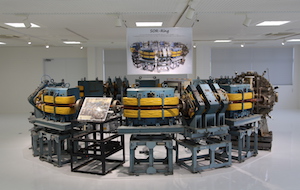 |
||
|
SOR-RING exhibited in the Center
|
 Questions about synchrotron radiation
Questions about synchrotron radiation
(3-1) What are the differences between synchrotron radiation, radiation and radioactivity?
Radiation, in the broad sense, refers to all kinds of electromagnetic waves and particle beams. However, in the narrow sense, radiation refers only to ionizing radiation such as X-rays, α-rays, β-rays, γ-rays, neutron beams, electron beams, ion beams, and cosmic rays. Electric waves, infrared rays, visible light and ultraviolet rays are not included. Synchrotron radiation is light (infrared rays, visible light, ultraviolet rays and X-rays) emitted when a high-energy charged particle such as an electron, a positron etc. curves in a magnetic field. Synchrotron radiation is a type of radiation in the broad sense, and is distinguished by its origin from other types of radiation.
Radioactivity means (1) the property emitting ionizing radiation such as α-rays, β-rays and γ-rays, (2) the degree of this property, and sometimes (3) substances of this property (radioactive materials). Thus radioactivity is absolutely independent of synchrotron radiation.
(3-2) What is the difference between synchrotron radiation and a laser beam?
Both Synchrotron radiation and a laser beam are directional light (electromagnetic wave).
However, synchrotron radiation is white light (an electromagnetic wave comprising all wavelength components) or semi-monochromatic light, which can be used as a bright monochromatic light source tunable over a wide range from X-rays to infrared rays.
In contrast, a laser beam is coherent and monochromatic light, its peak intensity is high, and the monochromatic light is available without spectrometers. However, the wavelength range is restricted to far-infrared rays to vacuum ultraviolet rays, and, at present, an X-ray laser is in developmental stages.
(3-3) What color is synchrotron radiation?
Light that the human eye can detect is called visible light. Synchrotron radiation is comprised of light with a wide distribution of wavelengths, including visible light, so it looks like white light. However synchrotron radiation is not directly observable at X-ray beamlines, which are most of the beamlines at SPring-8, because there are filters to cut off visible light and beryllium vacuum windows in the paths of the beamlines. Visible light from synchrotron radiation is observable at beamlines without any filters or windows, such as soft X-ray beamlines and infrared beamlines. It is noted that direct observation of the synchrotron radiation is quite dangerous. Indirect observation with a fluorescence screen is recommended for safety.
(3-4) What is the shape of synchrotron radiation immediately after it is emitted from a magnet?
Synchrotron radiation emerges in a fan-like shape from a bending magnet just like water droplets scattered from the edge of an umbrella when it is turned.
|
The horizontal spread of synchrotron radiation emitted from a bending magnet depends on the length of the magnet (the spread angle is 4.04 degrees for SPring-8's bending magnets). The vertical spread depends on the energy of the electron beam running in the Storage Ring, the magnetic field of the bending magnet, and the energy of the synchrotron radiation (for SPring-8's bending magnets, the spread angle is 0.0036 degrees or 62.5 micro radians for X-rays of 28.9 keV). |
|
(3-5) Is synchrotron radiation coherent?
Synchrotron radiation is not coherent. Research is presently being done at various facilities to produce coherent synchrotron radiation.
(3-6) Is light a wave or particles?
Although light is a wave (electromagnetic wave), it sometimes shows particulate behavior depending on how it interacts with matter. In general, long wavelength light shows a wave nature and short wavelength light shows a particulate nature.
 Questions about safety
Questions about safety
(4-1) Does synchrotron radiation affect human health similarly to ionizing radiation?
Synchrotron radiation is radiation (infrared rays, visible light, ultraviolet rays and X-rays) (*) generated in a specific way; therefore, excessive exposure to synchrotron radiation carries the same hazardous effects (burn by infrared rays, vision defects by visible light, skin injury by ultraviolet rays and X-rays etc.) as other types of radiation cause.
(*) In the broad sense, radiation refers to all types of electromagnetic waves and ion beam radiation. However, in the narrow sense, radiation refers only to ionizing radiation, such as X-rays, α-rays, β-rays, γ-rays, neutron beams, electron beams, ion beams and cosmic rays.
(4-2) Is radiation controlled at SPring-8?
The handling of radiation is stringently regulated by the law. At SPring-8, the radiation shielding has been designed with ample safety, and the full-time employees of the Radiation Safety Team oversee strict radiation management to comply with the law.
(4-3) Does the high magnetic field affect human health?
It is known that high static magnetic fields are a risk to people with cardiac pacemakers and surgical clips, and that high alternating magnetic fields can cause burn injury etc. However, there are few details concerning the effects of magnetic fields on human health.
(4-4) Do cosmic rays affect human health? Are they hazardous to human health?
Since the earth is protected from cosmic rays by geomagnetism and the geomagnetism surrounding the earth has shielding power equivalent to a water wall 10 m thick, the intensity of the cosmic rays that reach the ground is very low and they do not affect human health.
The living organisms on the earth have been exposed to low-level cosmic rays etc. and have evolved from a primitive unicellular organism. If there were any organism that could not bear even low-level radiation, it would not have survived the process of evolution. The intensity of cosmic rays becomes much higher outside the atmosphere, so the crews of the space shuttle are exposed daily to cosmic rays equivalent to more than one year's exposure at ground level.
[Note] At the Public Relations Center, we exhibit radiation detectors which can detect cosmic rays, such as a cloud chamber and a spark chamber, for the purpose of helping visitors understand radiation. However, neither the measurement nor the observation of cosmic rays is performed at SPring-8.
 Physical questions about electrons and accelerators
Physical questions about electrons and accelerators
(5-1) What is an electron?
An electron is one of the fundamental particles that constitute an atom. It is a negatively-charged particle, and moves around a nucleus. Electrons also run in the CRT (cathode-ray tube) of a TV set or a computer display and emit light onto the screen. Moreover, an electric current is generated when electrons move in metal.
(5-2) What color is an electron?
The color of a substance (a substance that itself does not glow) is determined by the wavelength components of visible light which it reflects or absorbs. Since the electron is extremely small and it is physically impossible to see an electron directly by visible light, the color of an electron is not defined. However, we can see the light emitted when electrons hit a substance like a fluorescent screen (however, this is not the light of an electron, but is the light the fluorescent material emits).
(5-3) What is an "electron volt" ?
The "electron volt" is a unit of energy. One electron volt is defined as the increase in kinetic energy of an electron when it is accelerated by an electric potential of one volt.
(5-4) How are electrons accelerated? How are the velocity of an electron and an electron beam controlled?
Thermoelectrons are generated by raising the temperature of a substance in a vacuum, and they are accelerated using a static electric field or a high-frequency electric field. Moreover, a magnetic field bends the electron beam and also focuses it like a lens.
(5-5) What is a microwave?
A microwave is an electromagnetic wave whose wavelength ranges from about 1 mm to about 1 m.
Microwaves are divided into subcategories including the submillimeter waves, the millimeter waves (EHF), the centimeter waves (SHF), and the decimeter waves (UHF), ordered by wavelength. The microwave ovens used at home generate microwaves with wavelengths of about 10cm; these waves cause the oscillation of water molecules contained in food, and the resulting frictional heat warms it.
(5-6) What is the electron beam traveling around the Storage Ring used for?
When the orbit of the electron beam traveling around the Storage Ring is bent by the magnet, the electron beam emits synchrotron radiation. Thus, the electron beam is used to generate synchrotron radiation.
(5-7) What is the final destination of the electrons traveling around the Storage Ring?
An electron loses its kinetic energy when it emits synchrotron radiation. Therefore, if the high-frequency accelerator is switched off, the orbital radius of the electron beam becomes smaller and smaller, until the electron beam collides with the vacuum chamber wall or a metal plate called the damper. When an energetic electron hits a substance, it loses its kinetic energy and stops. The kinetic energy is then changed into heat.
(5-8) Why is the cross-section of the electron beam passageway in the vacuum chamber elliptical?
|
Although the shape of the cross-section of the electron beam differs from place to place, it is, on average, elliptical. Since the cross-section of the electron beam passageway in the vacuum chamber has been designed so as to be similar to the cross-section of the electron beam, it is elliptical. |
|
(5-9) How was the circumference of the Storage Ring determined?
The radius of curvature of the electron beam is determined from the electron energy and the degree of deflection. Higher electron energy yields higher energy synchrotron radiation, and also requires a greater circumference of the Storage Ring. Moreover, a greater circumference enables the electron beam to be narrower and therefore allows a greater brilliance and higher energy of synchrotron radiation. However, the circumference of the Storage Ring actually depends on the construction budget.
(5-10) What is the frequency of electron injection?
The frequency of electron injection depends on the operating conditions. Top-up operation has been successfully used since June 2004 and to keep the stored current almost constant the electron beam is injected one or three times every one or five minutes. Before the top-up operation it was usually carried out either once a day (once in 24 hours) or twice a day (once in 12 hours) and there were several hundred electron fillings per injection at intervals of about 1 second.
 Technical questions about accelerators and synchrotron radiation generators
Technical questions about accelerators and synchrotron radiation generators
(6-1) What is the electron emitter in the electron gun made of?
Barium-impregnated tungsten is used at SPring-8.
(6-2) What material is used to construct the vacuum chamber that is the passageway for the electron beam, and how is the chamber made?
The vacuum chamber is constructed of aluminum alloy and is manufactured by the extrusion method. There are also some vacuum chambers made of stainless steel.
(6-3) Why is the vacuum chamber made of aluminum alloy? Is it possible to use other kinds of metal, for instance, stainless steel?
Aluminum alloy is best suited for construction of the vacuum chamber for the following reasons:
(a) It is a non-magnetic metal,
(b) It has good vacuum characteristics, that is, it can achieve high vacuum,
© It has good characteristics for radioactivation, that is, even if atoms in the aluminum alloy are radioactivated by high energy electrons, long-lived radio-isotopes are seldom generated,
(d) Owing to its good processing characteristics, it is possible to produce the chamber with a high degree of accuracy and at low cost. On the other hand, although stainless steel is also available for construction of the vacuum chamber, it is hard to process stainless steel by the extrusion method. Therefore, the production methods and cost for stainless steel are different from those for aluminum alloy.
(6-4) Is all the technology used at SPring-8 domestic?
The accelerators have been constructed and developed mostly with technology developed in Japan.
(6-5) What is the magnetic flux density generated by the magnet used in the undulator?
|
The magnetic flux density on the surface of the magnet is approximately 14,000 gauss at most. The magnetic flux density at the point where the electron beam passes is several thousand gauss. However, it depends on the type of undulator and on the magnet gap. |
|
(6-6) What components is the undulator magnet made of?
It is an anisotropic sintered magnet that is comprised primarily of neodymium, iron, and boron. The world's strongest permanent magnets are made with this compound. The magnetic performance of this undulator magnet does not degrade even after it is exposed to high temperatures.
SPring-8 uses many in-vacuum undulators. An in-vacuum undulator is one whose magnets are inserted into the high-vacuum region in which the electrons travel. In general, the gas that comes out of material in a vacuum makes high vacuum difficult to achieve. Therefore, to attain ultra-high vacuum, it is necessary to remove the gas in advance by heating the vacuum system. It is difficult to construct in-vacuum undulators with conventional magnets, because their magnetic performance degrades after heating. However, this heat-resistant neodymium-iron-boron magnet enabled construction of the in-vacuum undulator.
The neodymium-iron-boron magnet was developed in Japan. We can find some Japanese names in the history of invention of stronger magnets. Japan is on the leading edge of research on magnets and the study of magnetism is also conducted at SPring-8.
(6-7) Is the exciting current of the bending magnet alternating (AC) or direct (DC)?
The current for excitation of the bending magnet is direct (DC), because the energy of an electron beam in the Storage Ring is constant. The exciting current of 1,200 amperes generates a magnetic field of 7,000 gauss.
(6-8) What types of failures occur and how often do they happen?
The usable beam time during the scheduled operation of the Storage Ring in 2016 was 4,125 hours, and the downtime was 23 hours. Therefore, the downtime percentage was only 0.6% and this indicates that the operation at SPring-8 is highly stable worldwide. The causes of the major failures were a Discharge of high power high frequency system equipment and leakage of cooling hose for electromagnet, and machine glitches. There were also failures due to natural disasters such as lightning strikes and earthquakes.
(6-9) Why does SPring-8 have implements from several different manufacturers?
SPring-8 orders equipment and instruments from the manufacturer that possesses the necessary technology and excels at this technology. Consequently, the orders from SPring-8 were divided among several manufacturers.
 Questions about the use of synchrotron radiation and research results
Questions about the use of synchrotron radiation and research results
(7-1) How and at which beamline was the arsenious acid from the Wakayama curry-poisoning case analyzed?
The first measurement was carried out at the High Energy Inelastic Scattering Beamline BL08W. The second measurement, which was commissioned by the Wakayama District Court, was performed at BL08W and the Magnetic Materials Beamline BL39XU (called Physicochemical Analysis Beamline at that time). In both measurements, X-ray fluorescence analysis with synchrotron radiation is used.
When a substance is irradiated with X-rays, it emits fluorescent X-rays characteristic of an atom. Therefore, we can determine the type and quantity of the element contained in the substance by measuring the energy and quantity of fluorescent X-rays. Furthermore, it is a feature of this method that trace elements can be detected.
In the Wakayama curry-poisoning case, the arsenious acid was identified by comparing the quantities of specific impurities contained in the arsenious acid. Furthermore, this method enables the identification of the place of a material's production.
SPring-8's high energy X-rays enable the analysis of heavy elements, which has previously been unavailable; therefore, it was possible to detect the heavy arsenic (As) atoms of the arsenious acid, thus conclusively identifying the poison.
|
[Note] About the Wakayama curry-poisoning case: |
|
(7-2) Are there any examples of practical application in SPring-8's research results? What are some examples of practical application to actual life?
SPring-8 is useful to basic research because it is an experimental facility for the observation of substances at the atomic or electronic levels. However, SPring-8 has brought about many practical applications to actual life. For example, SPring-8 determined the cause of charging degradation characteristic of lithium batteries and therefore contributed to the extension of life of these batteries. In situ observation of the interatomic distance of an optical semiconductor device enhanced the oscillation efficiency of the device and improved its yield. The self-generation mechanism of a non-degrading catalyst for automotive emissions control was elucidated on the atomic level; this was useful to the commercial viability of this catalyst. For further information, please view a website, "Successful Results of Industrial Applications at SPring-8."
It is expected that structural analysis of proteins will lead to new drug designs.
(7-3) How is SPring-8 used for archaeological research?
Ancient artifacts including ancient pottery, old porcelain, old potsherds, Buddhist statues, ancient iron artifacts, bonze mirrors etc., have so far been analyzed by X-ray fluorescence analysis at SPring-8. When substance is irradiated with X-rays, it emits fluorescent X-rays characteristic of an atom. Therefore, we can determine the type and quantity of the element contained in the substance by measuring the energy and quantity of fluorescent X-rays (X-ray fluorescence analysis). This method has the distinction that a sample can be analyzed directly without destroying it or processing it chemically (non-destructive analysis). This feature is essential for precious cultural properties.
Trace elemental analysis of ancient artifacts is performed using synchrotron radiation. Comparison of trace element contents enables the identification of the production district and estimation of the artifact transport history. X-ray fluorescence analysis gives also information on manufacturing process of ancient artifacts. The application of synchrotron radiation to archaeology also plays a role to introduce scientific approach to the research area categorized as cultural studies in Japan.
(7-4) What is the size of a protein crystal sample used in structural analysis?
SPring-8's X-ray beam is very bright and very narrow, therefore even a small sample can be measured with it. As for a protein sample, it is usually a small single crystal of about 100 microns on a side. There is an actual example of structural analysis with a very small single crystal of about 10 microns (the structural analysis of a globular protein called flagellin that constitutes a bacterial flagellum).
In general it is difficult to generate a large single crystal of a protein. For this reason, there are many proteins the structural analysis of which would not have been possible without SPring-8.
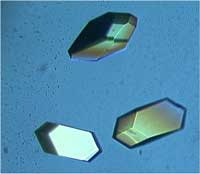
|
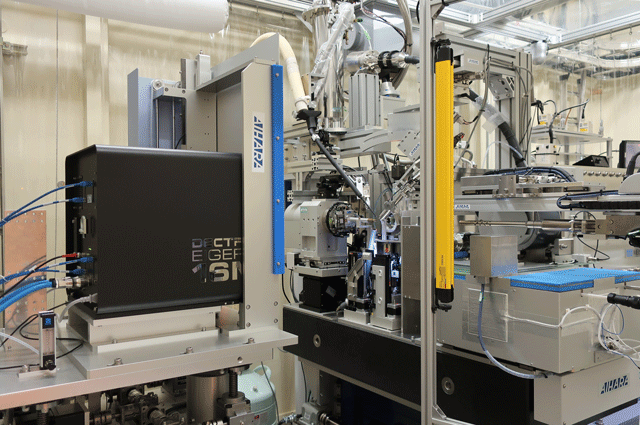 |
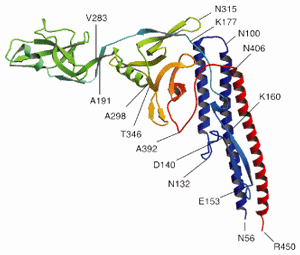 |
| The crystals of the human Rad52 protein, which plays a central role in homologous DNA recombination (size: approx. 300x200x100 µm) |
The protein single crystal structure analysis system at Structural Biology Beamline BL41XU |
The structure of a globular protein, flagellin
|
(7-5) Is SPring-8 involved in the Human Genome Project?
Although RIKEN (The Institute of Physical and Chemical Research) is involved in the Human Genome Project (a project to determinate the base sequence of the human genome), SPring-8 is not engaged in this project. However, SPring-8 is involved in the Structural Genome Project (a project to determine the primary and higher-order structures of a gene and the protein encoded by it).
Currently, SPring-8 has three public-use beamlines for protein structural analysis, and the Structural Genome Project uses 30% of the beam time of these beamlines. Moreover, RIKEN has two beamlines dedicated to structural genome research. The researchers from all over the country perform their experiments using these beamlines day and night.
(7-6) Is a protein crystal destroyed while it is exposed to X-rays to analyze the protein structure?
The structural analysis of protein starts with crystallization of the protein. The protein crystal is irradiated with X-rays, and X-ray diffraction is used to analyze the protein structure. A protein crystal contains a large number of water molecules, typically 50% by weight, and is soft unlike diamond or salt. When it is irradiated with X-rays, water molecules are ionized and the ions generate hydrated radicals by reacting with ambient water molecules. The hydrated radicals break chemical bonding in a protein molecule. Therefore, while a protein crystal is exposed to X-rays, the crystal is gradually damaged (radiation damage). A protein crystal, however, is comprised of billions of protein molecules, and so it takes a certain amount of time until the radiation damage causes detrimental effects on the collection of X-ray diffraction data. The data collection need to be completed within the time. The protein structural analysis experiments compete against radiation damage of crystals. As a matter of course, the experiment requires a device to slow the radiation damage. A protein crystal sample is usually frozen before experiment and squirted with cold nitrogen gas while exposed to X-rays.
 Questions about the SPring-8 facility
Questions about the SPring-8 facility
(8-1) What is SPring-8's receiving voltage? Where is the transformer station?
Electric power is supplied at 77,000 volts through two lines to the special high-voltage switching station in front of SPring-8's main gate. Power is supplied from the Technopolis Transformer Station of Kansai Electric Power Co. Inc.
|
From the special high-voltage switching station, power is distributed at 77,000 volts to the first special high-voltage transformer station (for the Storage Ring) on the SPring-8 campus, to the second station (for the Injection System, the Linear Accelerator and the Synchrotron), and to the third station (for the Accelerator and Beamline R&D Facility, the Structural Biology Facility, the New SUBARU, the XFEL Facility, etc.), where the power voltage is transformed from 77,000 volts to 6,600 volts. Then power is fed to a high-voltage transformer installed at each facility, where the voltage is reduced from 6,600 volts to 400 volts for motivity, 200 volts for lighting and 100 volts for outlets. |
|
(8-2) How large is the SPring-8 site?
The SPring-8 site covers 141 hectares (1,410,000 square meters). It is about 36 times larger than Koshien Ballpark, about 30 times larger than TOKYO DOME Stadium, and about 2.8 times larger than the Tokyo Disneyland theme park.
 Questions from users
Questions from users
(9-1) Why is SPring-8 shut down for a long time in summer?
For the regular inspection of SPring-8, the shutdown periods of approximately 1.5-2 months in summer and one month in winter are set. These periods are spent in the maintenance of SPring-8 facilities, the statutory inspection of electricity-receiving equipment, and the improvement of the accelerator system and beamlines for the enhancement of beam performance. The period for regular inspection is set longer in summer than in winter predominantly because the governmental financial office stipulates that light, fuel and water expenses should be reduced as much as possible. Therefore, from the viewpoint of economics, it is considered most effective to minimize the operation of SPring-8 as much as possible between July and September when the electricity unit cost is high. However, regarding the long-term shutdown of SPring-8 in summer, some users request the coordination of the shutdown period with another domestic synchrotron radiation facility from the viewpoint that "it should be available whenever needed." To meet these needs, we will do our best to coordinate the operation of SPring-8 and another facility, and to improve the operation schedule, such as shortening the shutdown period in summer, through efforts at SPring-8 with the assistance of the governmental financial office.
Please feel free to send your comments or questions to the Public Relations Division of SPring-8 at kouhou@spring8.or.jp
